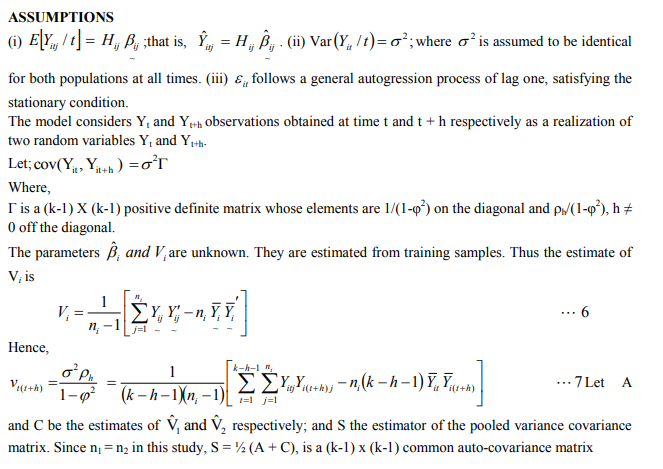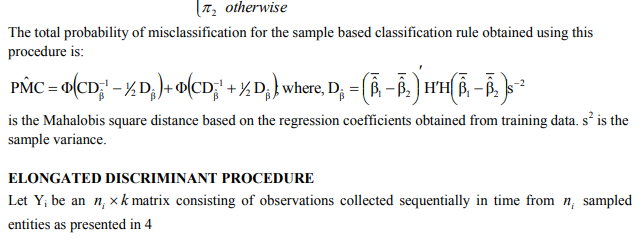IJCRR - 5(17), September, 2013
Pages: 01-09
Date of Publication: 12-Sep-2013
Print Article
Download XML Download PDF
COMPARISON OF CLASSIFICATION RULES FOR TWO UNIVERIATE POPULATIONS
Author: Hashimu Bulus
Category: General Sciences
Abstract:Three procedures for classifying an entity into one of the two predetermined univariate populations 1 and ?2 were derived, evaluated and compared. This paper proposes Unspecified structure of the variance, Regression Discriminant (RD) and Elongated Discriminant (ED) procedures for the classification using k repeated observations collected on each entity j at time t (t = 1,2,…, k;j = 1,2,…,ni; i = 1,2). Mean arterial pressure which is a function of systolic and diastolic blood pressures were collected sequentially in time from two sampled populations ?1(survivors) and ?2 (nonsurvivors),
of hypertensive patients admitted at the Jos University Teaching Hospital (J.U.T.H).Three techniques: re-substitution, leave \? one out and partitioning of samples are used to construct and evaluate the sample based classification rules. Probabilities of misclassification obtained from the confusion matrices produced by these techniques are used to compare the performances of these rules. The analysis reveals that the procedures compare favourably with one another and the Fisher's commonly used rule. The classification rule obtained using Elongated Discriminant procedure performs
better with lower error rates. This is followed by unspecified structure of the variance and regression discriminant procedure in that order.
Keywords: Classification Rule, Elongated Discriminant, Regression Discriminant, Unspecified variance –covariance structure and univariate populations
Full Text:
INTRODUCTION
Consider the classification rule for classifying an entity into one of the two predetermined univariate normal populations ?1 and ?2 based on observations collected at a single point in time











Table 3: Probabilities of Misclassification (PM.C) for the Three Procedures (Partition of Sample Technique)
Procedures Unspecified variance Regression Discriminant Elongated Discriminant PMC 0.5333 0.5500 0.3667
CONCLUSSION
The analyses reveal that whichever technique is used to construct and evaluate the sample based classification rule, the Elongated Discriminant procedure out performs the other two, with minimum probability of misclassification. This is followed by the Unspecified Structure of the Variance and then the Regression Discriminant procedures. The Re-substitution Technique is found to be most appropriate when estimating the apparent error rate (APERA), as this gives the minimum error rate for all the procedures. When actual error rate is desired, the technique of Leave one out and partition of sample are most appropriate.
References:
1. Bulus, H (2008). A Heuristic classification for Repeated Measure. Bagale Journal of Pure and Applied Sciences, Yola. Vol. 6, pages 38-46.
2. Ching-Tsao Tu and Chien-Pai Han (1982). Discriminant Analysis Based on Binary and Continuous Variables. Journals of the American Statistical Association.Vol.77, no 377, pages 447 – 454.
3. Hand, D. J. (1989). Discrimination and Classification. John Wiley and sons, New York.
4. Lachenbruch, P. A. (1975). Discriminant Analysis. Hafner press, New York.
5. Lawoko, C.R.O. and McLachlan, G.J. (1983). Some Asymptotic Results on the Effect of Autocorrelation in the error Rate of the Sample Linear Discriminant Function. Pattern Recognition, Vol. 16, pages. 119 – 121.
6. McLahlan, G. J. (1992). Discriminant Analysis and Statistical Pattern Recognition. John Wiley and sons Inc, New York.
7. Timm, N. H. (1975). Multivariate Analysis with Applications in Education and Psychology. Brooks / Cole Publishing Company, Monterey, California.
|






 This work is licensed under a Creative Commons Attribution-NonCommercial 4.0 International License
This work is licensed under a Creative Commons Attribution-NonCommercial 4.0 International License